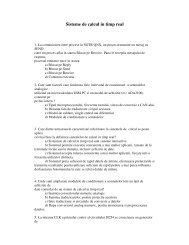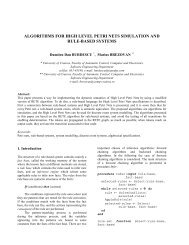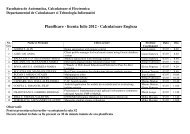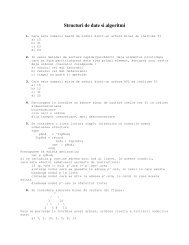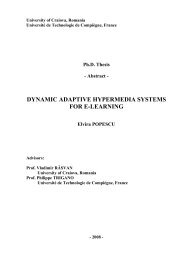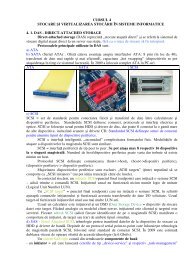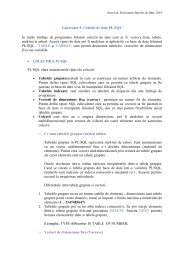Splay Trees
Splay Trees
Splay Trees
Create successful ePaper yourself
Turn your PDF publications into a flip-book with our unique Google optimized e-Paper software.
Purpose:<br />
− understand the notion of splay trees<br />
− to build, in C, a splay tree<br />
1 <strong>Splay</strong> <strong>Trees</strong><br />
1.1 General Presentation<br />
Laboratory Module 5<br />
<strong>Splay</strong> <strong>Trees</strong><br />
<strong>Splay</strong> trees are binary search trees that have implemented a self-adjusting mechanism. This mechanism<br />
performs in the following way: every time we access a node of the tree, whether for insertion or retrieval,<br />
we perform rotations (like in AVL trees), lifting the newly inserted/accessed node all the way up, so that it<br />
becomes the root of the modified tree.<br />
The nodes on the way are rotated such that the tree becomes more balanced. The splay tree is NOT a<br />
height balanced tree since there are situations when a node may have the balance factor different from -1, 0<br />
or +1. Nodes that are frequently accessed will frequently be lifted up to become the root, and they will<br />
never drift too far from the top position. Inactive nodes, on the other hand, will slowly be pushed farther<br />
and farther from the root. It is possible that splay trees can become highly unbalanced, so that a single<br />
access to a node of the tree can be quite expensive. Later in this section, however, we shall prove that, over<br />
a long sequence of accesses, splay trees are not at all expensive and are guaranteed to require not many<br />
more operations even than AVL amortized analysis trees.<br />
The analytical tool used is called amortized algorithm analysis, since, like insurance calculations, the<br />
few expensive cases are averaged in with many less expensive cases to obtain excellent performance over a<br />
long sequence of operations. The operations that are performed are rotations of a similar form to those used<br />
for AVL trees, but now with many rotations done for every insertion or retrieval in the tree. In fact,<br />
rotations are done all along the path from the root to the target node that is being accessed. Let us now<br />
discuss precisely how these rotations proceed.<br />
The structure of a splay node is similar with the one that was used fr binary search trees. Note the<br />
appearance of the parent pointer.<br />
struct Node<strong>Splay</strong>{<br />
int key;<br />
nod *left, *right, *parent;<br />
};<br />
Where:<br />
- key represents the tag of the node(integer number),<br />
- left, right and parent represent pointers to the left and right children and to parent node.<br />
1.2 Domains of Usage for <strong>Splay</strong> <strong>Trees</strong><br />
<strong>Splay</strong> trees are typically used in the implementation of caches, memory allocators, routers, garbage<br />
collectors, data compression, ropes (replacement of string used for long text strings), in Windows NT (in<br />
the virtual memory, networking, and file system code) etc.<br />
A splay tree is an efficient implementation of a balanced binary search tree that takes advantage of<br />
locality in the keys used in incoming lookup requests. For many applications, there is excellent key locality.<br />
A good example is a network router. A network router receives network packets at a high rate from<br />
incoming connections and must quickly decide on which outgoing wire to send each packet, based on the<br />
IP address in the packet. The router needs a big table (a map) that can be used to look up an IP address and<br />
find out which outgoing connection to use. If an IP address has been used once, it is likely to be used again,<br />
perhaps many times. <strong>Splay</strong> trees can provide good performance in this situation.<br />
1
Another example of a domain in which splay trees are used are Intrusion detection systems (IDS)<br />
which are an essential part of the security infrastructure. They are used to detect, identify and stop<br />
intruders. The administrators can rely on them to find out successful attacks and prevent a future use of<br />
known exploits. IDS are also considered as a complementary solution to firewall technology by recognizing<br />
attacks against the network that are missed by the firewall. Nevertheless, IDS are plagued with false<br />
positive alerts, letting security professionals to be overwhelmed by the analysis tasks. Therefore, IDS<br />
employ several techniques in order to increase the detection probability of suspect threats while reducing<br />
the risk of false positives. This leads to the construction of a decision tree such as the splay tree used to<br />
verify the traffic. The proposed strategy to detect intrusions using protocol analysis consists in extracting<br />
data from each received packet and then traversing a pre-built decision tree.<br />
The process of classifying packets into “flows” in routers, firewalls, packet filters etc., is called packet<br />
classification. Packet classification is used in a variety of applications such as security, monitoring,<br />
multimedia applications etc. These applications operate on packet flows or set of flows. Therefore these<br />
nodes must classify packets traversing through it in order to assign a flow identifier, called as Flow ID. Fast<br />
and efficient packet classification techniques are essential for the design of high-speed routers, and various<br />
other applications. In order to achieve this, a so called <strong>Splay</strong> Tree based Packet Classification (ST-PC)<br />
technique is used, which consists in using simple primitives in the design, namely splay tree models and<br />
prefix conversion methods.<br />
1.3 Operations on <strong>Splay</strong> <strong>Trees</strong><br />
MEMBER (i, S) - finds out if the element “i” is in the “S” splay tree;<br />
INSERT (i, S) - if the element “i” does not belong to the “S” splay tree, then the function inserts the<br />
element in the tree.<br />
DELETE (i, S) - if the element “i” is in the “S” splay tree, then the function deletes the element.<br />
JOIN (S, SP) - supposing that x < y, for any x of S and any y of SP, the function merges the “S” and<br />
“SP” splay trees.<br />
SPLIT (i, S) - splits the “S” splay tree in two different trees “SP” and “SPP” such that the keys respect the<br />
following : x
Zig-Zig<br />
Zig-Zag<br />
Figure 1. Zig-Zig move<br />
Figure 2. Zig-Zag move<br />
Zig<br />
Figure 3. Zig move<br />
3
1.3.2 Pseudocode for Operations in <strong>Splay</strong> <strong>Trees</strong><br />
MEMBER (S, k) {<br />
if ( *S == NIL )<br />
then return 0<br />
current = *S<br />
pred = NIL<br />
while ( current != NIL ){<br />
if (k == curent->element)<br />
then break<br />
pred = curent<br />
if ( k < curent->element )<br />
then current = curent->left<br />
else<br />
current = curent->right<br />
}//end while<br />
if ( current != NIL )<br />
then{<br />
splay(S, curent)<br />
return 1<br />
}<br />
else{<br />
splay(S, pred)<br />
return 0<br />
}// end MEMBER function<br />
INSERT (S, k){<br />
if (*S == NIL )<br />
then<br />
}<br />
(*S)->left = (*S)->right = (*S)->parent=NIL<br />
(*S)->element = k<br />
return<br />
current = *S<br />
anterior = NIL<br />
while ( current != NIL ){<br />
if ( k == curent->element )<br />
return<br />
anterior = curent<br />
if ( k < curent->element )<br />
then<br />
directie=LEFT<br />
current = curent->left<br />
else<br />
directie = RIGHT<br />
current = curent->right<br />
curent->element = k<br />
curent->left = curent->right = NIL<br />
curent->parent = anterior<br />
if ( directie == LEFT )<br />
then anterior->left = curent<br />
else<br />
anterior->right = curent<br />
splay(S, curent)<br />
4
DELETE (S, k) {<br />
if ( MEMBER(S, k) ){<br />
then SL = (*S)->left<br />
if ( SL )<br />
then SL->parent = NIL<br />
SR = (*S)->right<br />
if ( SR )<br />
then SR->parent = NIL<br />
join(SL, SR, S)<br />
}<br />
}<br />
JOIN (SL, SR, S){<br />
if ( SL )<br />
then<br />
}<br />
else<br />
return<br />
SPLIT (S, SL, SR, in){<br />
If ( S )<br />
then<br />
}<br />
else<br />
return<br />
member( &SL, PLUS_INFINIT)<br />
SL->right = SR<br />
if ( SR )<br />
then SR->parent = SL<br />
*S = SL<br />
if ( SR )<br />
then *S = SR<br />
else<br />
*S = NIL<br />
*SR = *SL = NIL<br />
MEMBER( &S, in)<br />
*SL = S<br />
*SR = S->right<br />
(*SL)->right = NIL<br />
SINGLEROTATE ( x ){<br />
if ( x->parent->left = x )<br />
then zig_left(&x)<br />
else<br />
zig_right(&x)<br />
}<br />
DOUBLEROTATE( x ){<br />
if ( x->parent->left == x and x->parent->parent->left == x->parent)<br />
then zig_zig_left(&x)<br />
return<br />
if ( x->parent->left == x and x->parent->parent->right == x->parent)<br />
then zig_zag_left(&x)<br />
return<br />
if (x->parent->right == x and x->parent->parent->right == x->parent)<br />
then zig_zig_right(&x)<br />
return<br />
5
}<br />
if ( x->parent->right == x and x->parent->parent->left == x->parent)<br />
then zig_zag_right(&x)<br />
return<br />
SPLAY( S, crt){<br />
father = crt->parent<br />
while ( father != NIL){<br />
if ( father->parent == NIL)<br />
then SINGLEROTATE(crt)<br />
else<br />
DOUBLEROTATE(crt)<br />
father = crt->parent<br />
}//end while<br />
*S = crt<br />
}<br />
ZIG_LEFT(x){<br />
splay_node *p, *b<br />
p = (*x)->parent<br />
b = (*x)->right<br />
(*x)->right = p<br />
(*x)->parent = NIL<br />
if ( b != NIL )<br />
b->parent = p<br />
p->left = b<br />
p->parent = (*x)<br />
}<br />
ZIG_RIGHT(x){<br />
splay_node *p, *b<br />
p = (*x)->parent<br />
b = (*x)->left<br />
(*x)->left = p<br />
(*x)->parent = NIL<br />
if ( b != NIL )<br />
b->parent = p<br />
p->right = b<br />
p->parent = (*x)<br />
}<br />
ZIG_ZIG_LEFT(x){<br />
splay_node *p, *g, *ggp<br />
splay_node *b, *c<br />
p = (*x)->parent<br />
g = p->parent<br />
b = (*x)->right<br />
c = p->right<br />
ggp = g->parent<br />
(*x)->right = p<br />
p->parent = (*x)<br />
p->right = g<br />
g->parent = p<br />
if ( b != NIL )<br />
b->parent = p<br />
6
}<br />
p->left = b<br />
if ( c != NIL )<br />
c->parent = g<br />
g->left = c<br />
(*x)->parent = ggp<br />
if ( ggp != NIL )<br />
if ( ggp->left == g )<br />
ggp->left = (*x)<br />
else<br />
ggp->right = (*x)<br />
ZIG_ZIG_RIGHT(x){<br />
splay_node *p, *g, *ggp<br />
splay_node *b, *c<br />
p = (*x)->parent<br />
g = p->parent<br />
b = (*x)->left<br />
c = p->left<br />
ggp = g->parent<br />
(*x)->left = p<br />
p->parent = (*x)<br />
p->left = g<br />
g->parent = p<br />
if ( b != NIL )<br />
b->parent = p<br />
p->right = b<br />
if ( c != NIL )<br />
c->parent = g<br />
g->right = c<br />
(*x)->parent = ggp<br />
if ( ggp != NIL )<br />
if ( ggp->left == g )<br />
ggp->left = (*x)<br />
else<br />
ggp->right = (*x)<br />
}<br />
ZIG_ZAG_LEFT (x){<br />
splay_node *p, *g, *ggp<br />
splay_node *a, *b<br />
p = (*x)->parent<br />
g = p->parent<br />
ggp = g->parent<br />
a = (*x)->left<br />
b = (*x)->right<br />
(*x)->left = g<br />
g->parent = (*x)<br />
(*x)->right = p<br />
p->parent = (*x)<br />
if ( a != NIL )<br />
a->parent = g<br />
g->right = a<br />
if ( b != NIL )<br />
7
}<br />
b->parent = p<br />
p->left = b<br />
(*x)->parent = ggp<br />
if ( ggp != NIL )<br />
if ( ggp->left == g )<br />
ggp->left = (*x)<br />
else<br />
ggp->right = (*x)<br />
ZIG_ZAG_RIGHT(x){<br />
splay_node *p, *g, *ggp<br />
splay_node *a, *b<br />
}<br />
p = (*x)->parent<br />
g = p->parent<br />
ggp = g->parent<br />
a = (*x)->left<br />
b = (*x)->right<br />
(*x)->right = g<br />
g->parent = (*x)<br />
(*x)->left = p<br />
p->parent = (*x)<br />
if ( a != NIL )<br />
a->parent = p<br />
p->right = a<br />
if ( b != NIL )<br />
b->parent = g<br />
g->left = b<br />
(*x)->parent = ggp<br />
if ( ggp != NIL)<br />
if ( ggp->left == g)<br />
ggp->left = (*x)<br />
else<br />
ggp->right = (*x)<br />
1.3.3 Sample Operations in a <strong>Splay</strong> Tree<br />
1.3.3.1 Insertion Example<br />
Figure 4.a presents the initial splay tree in which it will be performed the insertion of key 4. At<br />
first step, key 4 is inserted as leaf node. Figure 4.b presents the shape of the splay tree after setting node<br />
with key 4 as left child of node with key 5. After this step there will be performed rotations that will push<br />
the node with key 4 up to the root position.<br />
Figure 4.c presents the splay tree after performing a zig-zag rotation on node with key 4. The<br />
effect of this rotation is lifting up the node with key 4 with two levels.<br />
Figure 4.d presents the splay tree after performing a zig rotation on node with key 4. The effect of<br />
this rotation is lifting up the node with key 4 with one level in the root position.<br />
8
a) b)<br />
c)<br />
d)<br />
Figure 4. Insertion steps in a splay tree<br />
1.3.3.2 Join Example<br />
There are given two splay trees. They are presented in figures 5.a and 5.b. The figure 5.c presents<br />
the resulted tree.<br />
The first step is to perform a MEMBER operation on the largest key in the first splay tree. This<br />
operation will bring node with key 15 in the root position for the first splay tree.<br />
The second step is to link the root of the second splay tree as right child of the previously obtained<br />
root for the first slay tree. After this step the tree from figure 5.c is obtained.<br />
9
Figure 5. Join example<br />
1.3.3.3 Split Example<br />
There is given a splay tree and a key that belong to it. Figure 6.a presents this initial splay tree and<br />
the splitting key is 6. The split function will produce two splay trees: one with keys smaller than 6 and one<br />
with keys greater than 6.<br />
The first step is to perform a MEMBER operation on node with key 6. After this operation is<br />
performed the splay tree will look like in figure 6.b.<br />
Once the splitting key has been lifted up as root node the needed left splay tree and right splay tree<br />
are represented by the left and right children of the root.<br />
a)<br />
10
1.3.3.4 Deletion Example<br />
b)<br />
Figure 6. Split example<br />
There is given a splay tree as presented in figure 7.a. The task is to delete node with key 63 from<br />
the splay tree. The first step is to perform a MEMBER operation on node with key 63. This step will bring<br />
node with key 63 as root node. After this operation the splay tree will look like in figure 7.b<br />
a)<br />
The second step is to perform a join operation on<br />
left and right subtrees of node 63. These subtrees<br />
are marked in figure 7.b. The outcome of this<br />
procedure is presented in figure7.c.<br />
b)<br />
c)<br />
Figure 7. Deletion example<br />
11
2. Assignments<br />
1) Write a program that creates and manages a splay tree. The program must implement the following<br />
operations: creation, insertion, deletion, join, split, and tree display. The program should present a<br />
meniu where user may choose from implemented options.<br />
2) It is given the <strong>Splay</strong> tree from the following figure.<br />
Present the shape of the tree after each of the following operations:<br />
- INSERT 3<br />
- INSERT 24<br />
- INSERT 27<br />
- INSERT 37<br />
- DELETE 24<br />
- DELETE 55<br />
- SPLIT 40<br />
For each insertion operation there must be presented the following:<br />
- Initial position of the key into the <strong>Splay</strong> tree<br />
- Each rotation type that needs to be performed and how the rotation will perform<br />
- The final shape of the tree<br />
For each deletion operation there must be presented the following:<br />
- The search of the tree for the key that needs to be deleted<br />
- Each rotation type that needs to be performed and how the rotation will perform<br />
- The Join operation of the left and right subtrees<br />
- The final shape of the tree<br />
For the split operation there must be presented the following:<br />
- The search of the tree for the key used for the split<br />
- Each rotation type that needs to be performed and how the rotation will perform<br />
- The obtained left and right subtrees<br />
3) Perform a join operation on the following splay trees.<br />
12



